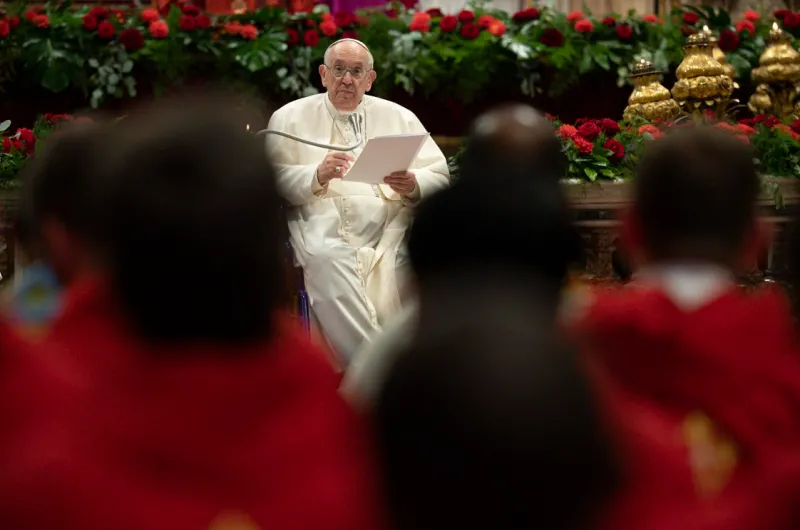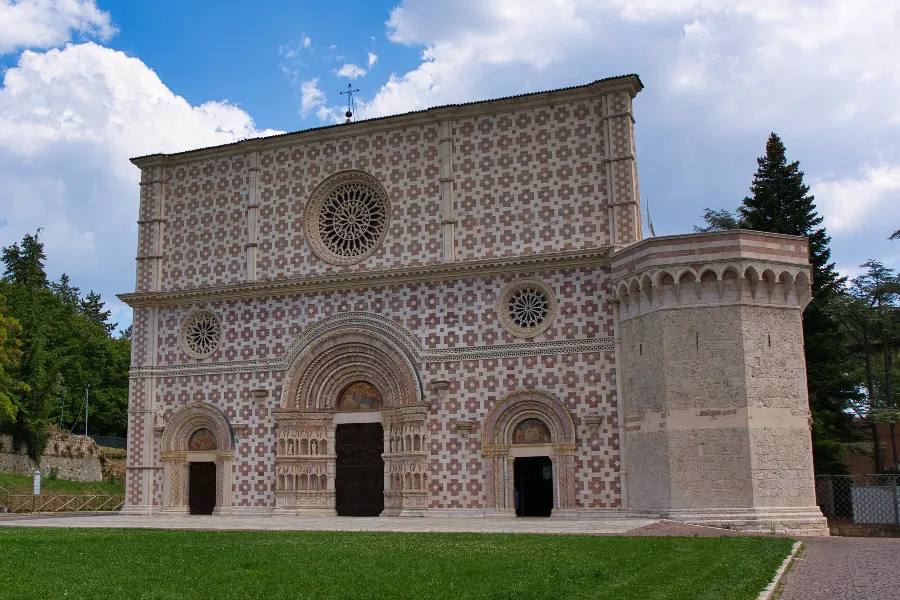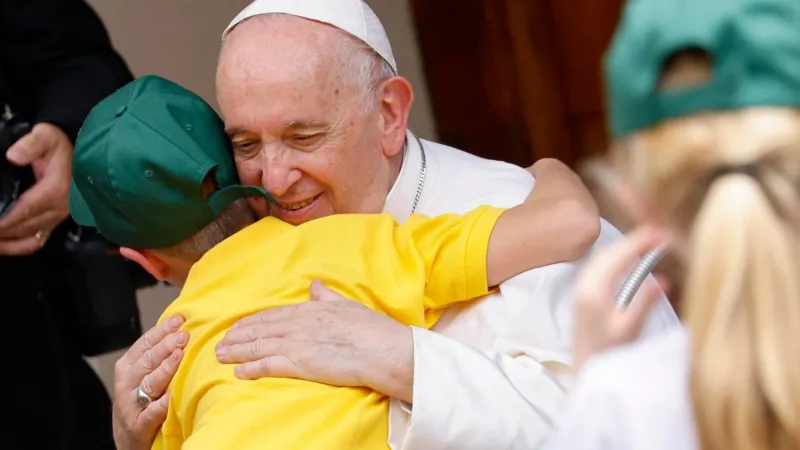
Rome Newsroom, Jun 7, 2022 / 05:25 am (CNA).
The news that Pope Francis will visit the Italian city of L’Aquila on Aug. 28 seemed to come out of the blue. But the trip was already being spoken of in February.
The city in central Italy hosts an annual event at the end of August known as the Celestinian Forgiveness. The pope recently announced that he will create new cardinals on Aug. 27, the day before his trip. Therefore, it seems that he planned the consistory around his visit to L’Aquila, rather than vice versa.
The Celestinian Forgiveness (Perdonanza Celestiniana in Italian) is a great legacy that Pope Celestine V left to the Church. He was pope from July 5, 1294, to Dec. 13 of that year, when he resigned from the office.
The 13th-century pope, also known as Peter of Morrone, is a figure of controversy. Many have associated him with the figure of the sick man in Dante’s “Divine Comedy,” who is described as “the one who out of cowardice made the great refusal.”
Yet he was in his own way a revolutionary pope. He was the first pontiff to exercise his ministry outside of Rome. He was based in L’Aquila (which means “the Eagle” in English), then a young city that had welcomed him after a period of living as a hermit.
The cardinals elected Celestine V after two years of internal strife, thinking that, given his age and personality, he would be a malleable pope. They were wrong. And during those few months of his pontificate, in the midst of the pressures that later led to his resignation, he established the Celestinian Forgiveness.

The bull of forgiveness drawn up by Celestine V offers a plenary indulgence to all who, having confessed and repented of their sins, go to the Basilica of Santa Maria di Collemaggio from Vespers on Aug. 28 to sunset on Aug. 29. It was a free indulgence and subject only to the bond of personal repentance. It was therefore open above all to the poor and dispossessed.
Celestine then renounced the papal throne, and died a prisoner in 1296. He was canonized in 1313, with the name of Peter the Confessor, testifying that his reputation as a pious man was not affected by the circumstances of his death.
Every year for the Celestinian Forgiveness, there is a guest cardinal who opens the holy door of Santa Maria di Collemaggio, after a reading of the bull of forgiveness by the local mayor. Celestine donated the bull to L’Aquila and it is kept in an armored chapel in the tower of the town hall.
This year, it will therefore be Pope Francis who opens the holy door. The invitation, as mentioned, was delivered in February by Cardinal Giuseppe Petrocchi of L’Aquila. It was followed by inspections by Vatican officials who prepare papal visits.
Around this short trip, Pope Francis built a consistory. On Aug. 27, he will create 21 new cardinals, of whom 16 will have the right to vote in a future conclave. On Aug. 28, he will not follow the usual custom of celebrating Mass with the newly created cardinals, but will travel instead to L’Aquila. And on Aug. 29-30, there will be, for the first time in seven years, an extraordinary consistory attended by the world’s cardinals to discuss the new Vatican constitution.
That the consistory was built around this event has invited speculation that the 85-year-old pope, who is currently making public appearances in a wheelchair, is planning to resign.
There is a precedent: Benedict XVI visited L’Aquila on April 28, 2009, to bring comfort to a population shocked by a recent earthquake that had hit the city hard. He stopped off at Santa Maria di Collemaggio, although the structure was not safe after the earthquake.
In front of the crystal coffin containing Celestine V’s body, Benedict XVI removed his pallium and placed it on the glass. In hindsight, the gesture was interpreted as a sign that one day Benedict XVI would resign — or that he had already thought of this possibility.

But Pope Francis may not be going to L’Aquila to send a signal about the end of his pontificate. There are other possibilities. The visit could be connected to previously rumored plans that he is preparing new norms concerning the status of a pope emeritus.
This is a plausible hypothesis given that, since Benedict XVI’s resignation in 2013, the role of the pope emeritus has never been defined in law. After all, the few previous popes emeritus did not live for long or else died (like Celestine V) as prisoners.
Another possibility is that the pope will announce a reform of the rules governing conclaves, perhaps increasing the number of cardinal electors and maybe also including non-cardinals, following the thought of Paul VI, who considered permitting the presidents of episcopal conferences to attend conclaves.
It’s noteworthy that Cardinal Oscar Andrés Rodriguez Maradiaga, president of the Council of Cardinals, spoke about the possibility of new norms concerning the Sede Vacante period at the launch of his new book in Rome on May 5.
The possibility that Pope Francis will use the L’Aquila visit to announce his resignation currently seems unlikely given the pope’s determined personality. At the same time, however, he does not want to let his reforms become a dead letter, and so a resignation, accompanied by new norms on the pope emeritus and the Sede Vacante period, could theoretically offer him a degree of control over the papal succession. But that is mere speculation.
What is certain is that the Church today needs a defined juridical framework, especially when the new Vatican constitution must be put into practice and harmonized with established practices and law.
Pope Francis’ visit to L’Aquila will no doubt come to have its own symbolic meaning. But it remains to be seen which one he will give to it.
If you value the news and views Catholic World Report provides, please consider donating to support our efforts. Your contribution will help us continue to make CWR available to all readers worldwide for free, without a subscription. Thank you for your generosity!
Click here for more information on donating to CWR. Click here to sign up for our newsletter.







Will the mysterious disclose itself? However it may signify Aquila was the Italian seat of the Hohenstaufen Holy Roman emperors. A German dynasty in constant territorial conflict with the Papal States frequently a formidable threat to its viability. Roger II [I believe] Norman king of Sicily was petitioned by the pope to defend the States against Heinrich II Rogers’ army rushing N and defeating Heinrich. Nevertheless the Hohenstaufens remained in power until 1250 with the last Frederick II king of Sicily and Holy Roman emperor. Celestine assumed the papacy 1294. Aquila remained a center of power brokers and primacy Manfred Hohenstaufen defeated by Charles II of 1382 to 1556 circa 1260.
Why Celestine V after his resignation 1294 died a prisoner of pope Boniface chose to reign as pope in Aquila [as Gagliarducci notes Aquila means eagle. In this instance the Hohenstaufen black eagle which would become the ensign of the future German state] instead of Rome remains another mystery. Was it that Aquila was thought a quasi independent non papal entity [although it was assigned bishops] Celestine a form of outcast disenchanted with Roman chicanery? That notion of outcast and reneger of duty has haunted Benedict XVI since he resigned. Benedict is said to have visited Celestine’s tomb leaving his pallium on the bier, seemingly [to this writer] an empathetic nexus with Celestine, Benedict soon to follow.
Pope Francis has made himself a type of outcast to many on the traditional side of Catholicism. As Andrea Gagliarducci speculates with the rest of us, might resignation be a means to consolidate his legacy as pope emeritus? We’ll only know when we know. Our task. Be ever faithful to Christ above and beyond the speculative maneuvers.
Note: 1382 to 1556 was meant to date the period of Aquila becoming an independent entity and center of power brokers.